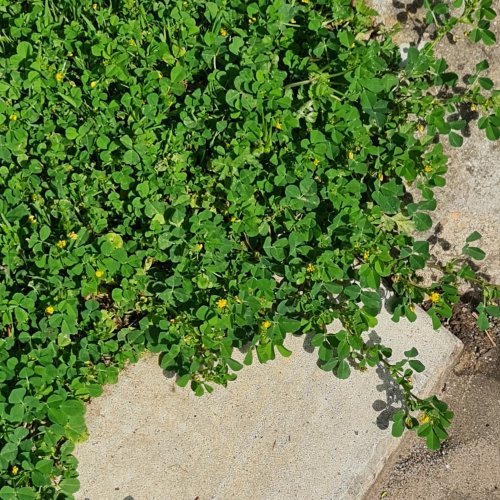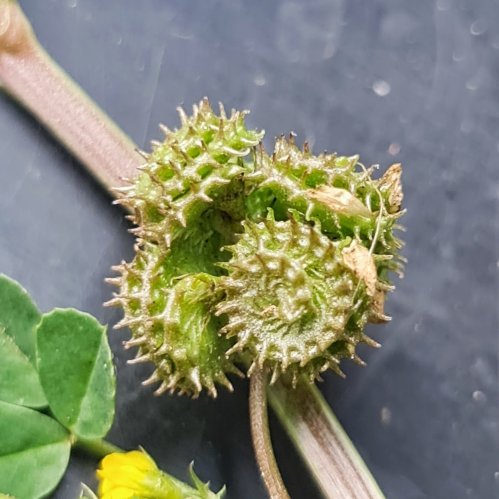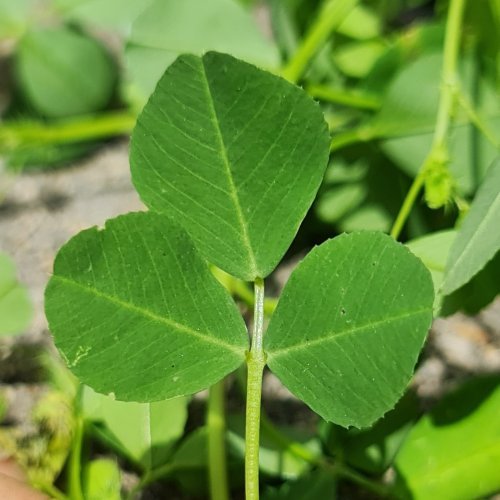The Burr Medic story. Even the worst have a job to do.

Anyone who has ever worn socks in Summer or owns a pet will know Burr Medic (Medicago polymorpha)! It’s spiny little seed cases get stuck in anything fibrous weather man made or furry. It is equally a curse for folks who like their lawns immaculate.
But that’s all a human centred view. In our ecosystems, it has several valuable uses.
It’s got a job to do
We just have to face it, Nature doesn’t like bare soil and does whatever She can to cover it. Bare soil is seen as a wound and needs to be protected and restored. That’s where Burr Medic comes in.
This tough little plant is a coloniser that excels at its job. Its mat of leaves act as a bandaid for the bare soil, covering it and protecting it from further damage. Burr Medic has other uses too. It has a deep taproot that penetrates deep into the soil, breaking up compaction. This taproot brings nutrients to the above ground parts of the plant which, when they die, add them to the surface as organic material which can be further broken down my various microfauna. This organic material also protects the soil from damage as well as increasing its water retention capability . When it dies, the taproot provides convenient food for soil fauna and when digested, leaves a path for water and oxygen to penetrate into the soil.

Burr Medic is a Legume too and, like the other well known members of that Family (Leguminosae) Beans and Peas, provide nitrogen to the soil which is invaluable in so many biological processes. The nitrogen fixing bacteria which do this job are located in nodules on the roots and when the rest of the plant does or they are broken off, they decay and their valuable cargo of nitrogen makes its way into the soil. The bacteria need to live inside these nodules because the process by which they gain energy and fix nitrogen is an anaerobic one (that is, without oxygen) and the walls of the nodule keep the oxygen out.

The tiny Pea flowers (which help to define its Family) of Burr Medic provide a food source for many tiny creatures, both pollinators and predators, greatly increasing the biodiversity that would be lacking on bare soil.

As with many coloniser plants, Burr Medic produces a prolific amount of seeds and has an effective dispersal mechanism the tiny hooks on the seed pods snag into anything furry that brushed against them and they are, thus, transported further afield.
Interestingly, at Ligaya Garden, we have only been graced with the presence of Burr Medic since I started regularly mowing the road verge. Before that, we saw it only in neighbours gardens and in other verge areas but now it’s here. It’s a pain to have and even the kindest thoughts and recognition of its role don’t endear it to me but it does it’s job well and I’ll leave it on the verge and just pick off the occasional specimens that pop up inside the fenceline.

Control
If you must remove Burr Medic, there are several methods that you can try before reaching for the herbicides.
Because it is a coloniser, it tends to minimise its presence once the soil is repaired. Adding goodly amounts of organic material to increase water holding capacity and soil structure is a good way toward deterring it or getting rid of it.
The seed pods are a problem that is best dealt with by regular removal such as mowing before it sets flowers and seeds. removal of the crown at the soil level leaves the organic material of the taproot to decay in the soil. Once seeds have been set, laying an old blanket over the area can pick up a lot of them. Then you just need to pick them off of tee blanket and dispose of them.
Burr Medic germinates in late winter so observation and removal of the young seedlings can help stop it from getting a foothold. At this stage, I pour boiling water over newly established plants and that kills them off nicely.








The second plant ☘️ look like a caterpillar. That's so wonderful. Thanks so much for sharing.
I never realised that but you're right,the seed does look like a curled up caterpillar! Well spotted!
Rabbit food! Although I think my bunnies are getting a bit sick of it lately. They'll eat the seeds as well when they are still green, so I've been trying to get as much to them as I can recently.
That's good to know that something eats them! I've tried them on the chooks and quails but besides a bit of initial fussing, they're pretty well ignored. Our neighbour has both Rabbits and Burr Medic. I'll recommend she tries feeding some to them.
My chickens will eat it, but I chop fine or give it them after mowing. They don't really get to forage often, so they love their greens when they get them.
It's another use that I'll put on my website
I do know this legume all too well. It colonized the lawn at my previous house and was quite difficult to remove by hand as the tops tend to break off the root when pulled.
Sounds like their advantages actually outweigh the nuisance that they are so maybe the next time I have a lawn I'll go more easily on them. I've seen a lot of small flying insects that love their flowers.
You can tell legumes by their flower shape. It's pretty distinctive. All wild plants have advantages that outweigh the disadvantages - except for when their seeds are stuck in our socks! Burr medic sure does attract so many small insects - generally they're too quick for me to identify lol!
Yes I can believe that they all have uses and advantages, I laughed at the burrs in socks though, that is rather annoying.
We so often overlook the value that these plants have just because they are considered weeds by some. They all have a role to play even when they're taking up space in a lawn and making it seem unkempt. I quite like the pioneer plants because they play such a vital role in reversing soil erosion.
I just took a foraging trip on the weekend and a lot of what I taught was about erosion control
Is Burr Medic a weed? because it will cover the vacant land.
It is interesting to discuss about this nature, because in it there are advantages that we do not fully know.
'Weed' is only an artificial construct. Nature doesn't have weeds, it just has colonisers, soil builders, biodiversity enhancers, pollution filters, pumps and air cleaners 😁
Hahaha, I don't really understand about it, it seems I have to learn a lot more to make nature a special place. 😁😁
lol It is already a special place
Hi @ligayagardener, your post has been upvoted by @bdcommunity courtesy of @rem-steem!
Support us by voting as a Hive Witness and/or by delegating HIVE POWER.
JOIN US ON
Cool! Thanks!
We have this in South Africa as well. I always got them stuck in my socks as a kid.
This article makes me wonder then at the health of the soil this undesirable "weed" plant actually provides and what other plants do the same!
Weeds are great indicators of soil health!
Indeed... but it is ironic that the weeds will grow everywhere when the grass and such don't want to 🙈
grass is weak, weeds are strong
🤣🤣🤣🤣 indeed!
Loving this plant and all soil protectors. I think the best way to go about them is just chop and drop, leave it in the same place to compost itself and prevent sunlight from germinating more seeds. Awesome that it's also a legume, personally I can't have enough of those around hehe
It definitely took a shift of perspective for me to get to love it. @minismallholding reckons her chickens love it!
Your post has been chosen by @ligayagardener for the next addition of 'The Garden Shed', a collection of archived posts by @gardenhive that feature useful gardening advice, DIY tips, homesteading tips and inspiring gardens.